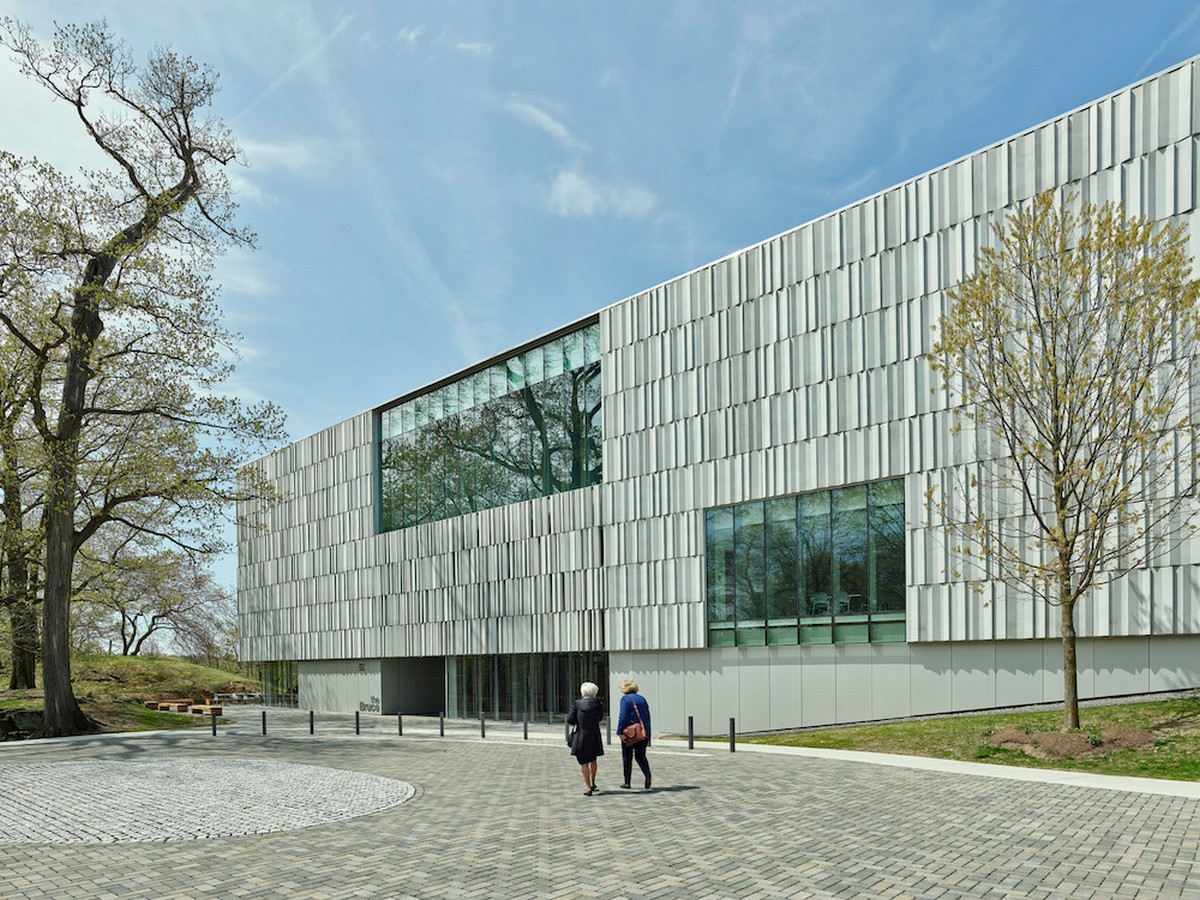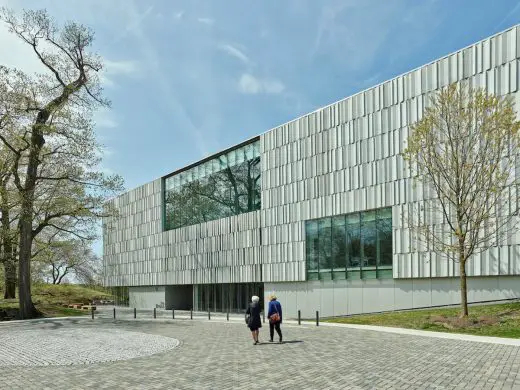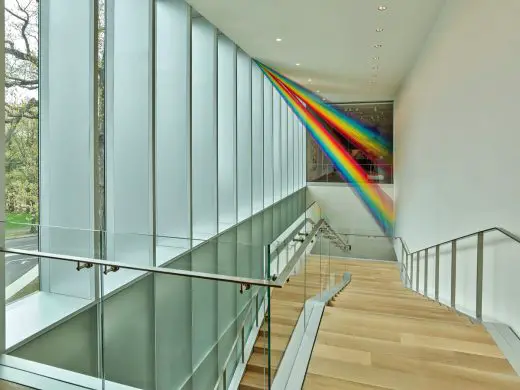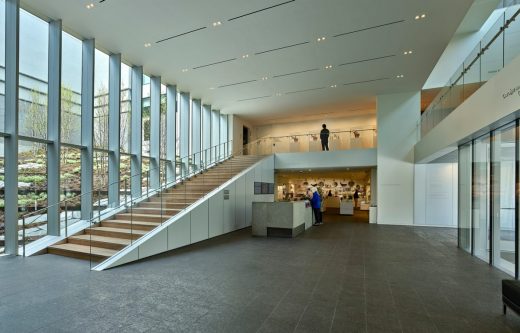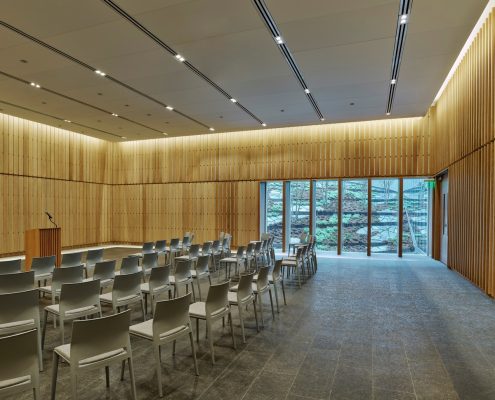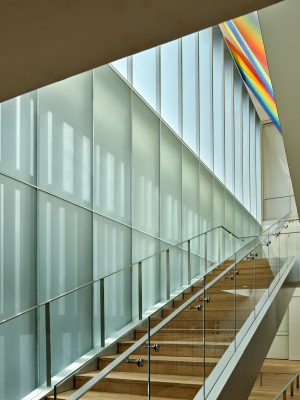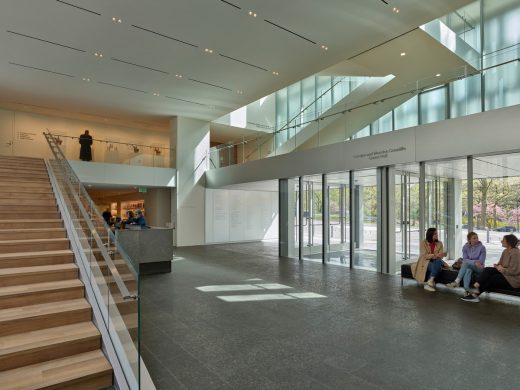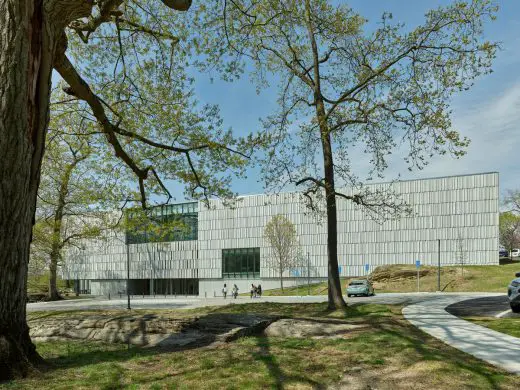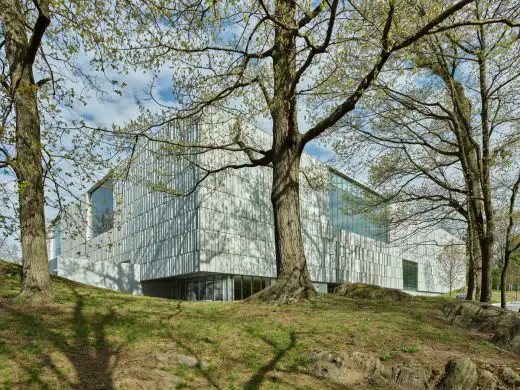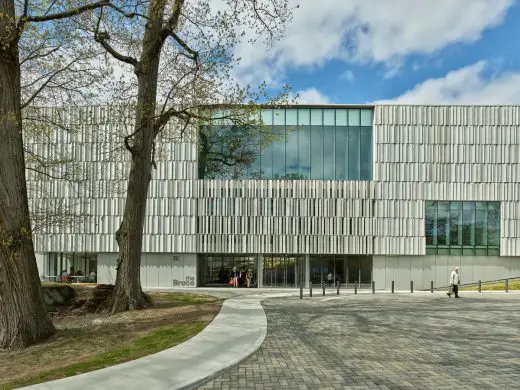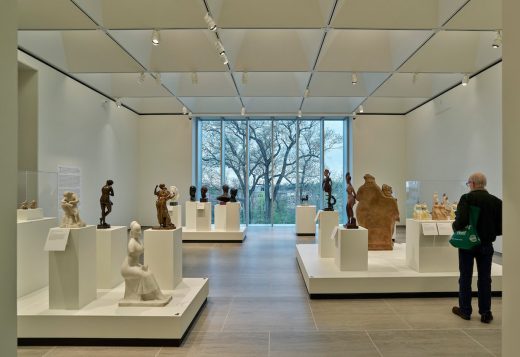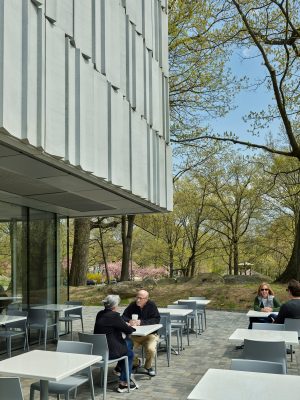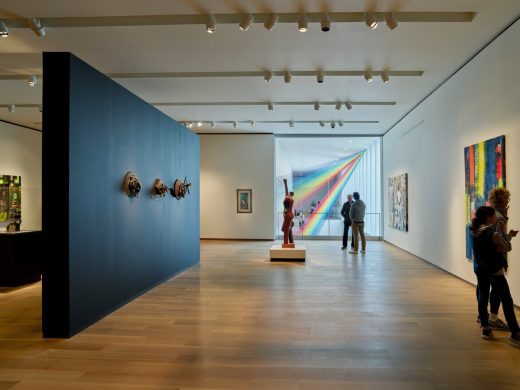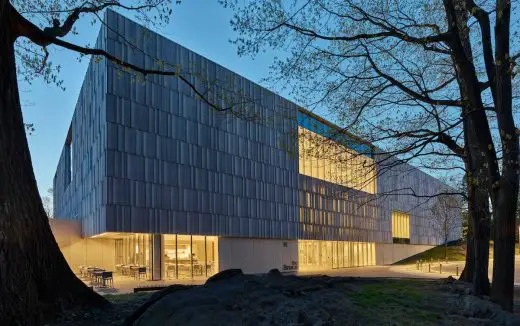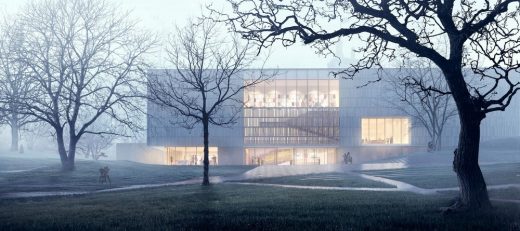Bruce Museum Greenwich, Connecticut building expansion, American architecture images, CT property
Bruce Museum in Greenwich, Connecticut
Contemporary Public Building Extension, CT design by EskewDumezRipple, USA
Updated May 9, 2024
Design: EskewDumezRipple
Location: Greenwich, Connecticut, USA
Photos by Tim Hursley
Bruce Museum in Greenwich, CT
The Bruce Museum is a regional cultural institution located in Greenwich, Connecticut with a multi-disciplinary collection and exhibition program bringing together art, science, and natural history.
In 2014, following a national design competition, the Bruce embarked on a journey to revitalize its campus to carry the institution into the future. Following the competition, the design team led a rigorous initial programming study to dig deep into the needs of the museum and support its ability to serve as a community resource.
The resulting project is a comprehensive renovation of the existing museum’s 32,500-square-foot structure along with a 42,000-square-foot addition, providing permanent and changing gallery space, expanded collection storage, and a new public entrance lobby and lecture hall for the museum. Comprising three floors, the expansion more than doubles the existing area of the facility and creates a welcoming visitor experience with clear circulation, generous galleries, and sufficient exhibition, storage, and archival spaces for the Museum’s growing collection.
The new design addresses the problematic visitor wayfinding of the previous museum design. Prior to this expansion, the museum entry faced north towards noisy Interstate-95, located at the top of a hill and hidden from view of visitors arriving to the site. The new design reorientates the entrance to face the adjoining Bruce Park, providing visitors with an immersive landscape experience prior to their entrance into the museum. Because the addition primarily stands apart from the existing house, the design team worked to develop a courtyard space between the two structures, one that serves to extend the park into the footprint of the museum to orient visitors as they move throughout the space.
Since opening, the museum’s new spaces have quickly become a catalyst for diverse forms of engagement. The double height lobby, café and gift shop seamlessly merge to create an open and free-flowing public space. The new lecture hall has become a hub for community programming, celebratory gatherings, and public lectures and receptions. New changing and permanent galleries enable the museum to host new, ambitious exhibitions and provide opportunities for engagement and education.
“We can host the community in a way we’ve never been able to before,” Bruce Museum Executive Director Robert Wolterstorff says. “In the past, we had no permanent collections galleries.” By adding these spaces, the museum is able to showcase works that local collectors have generously donated, providing the impetus for other collectors to do the same.
Natural daylighting was fundamental to the design concept. Openings in the façade suffuse the interior spaces with light, gradually receding in intensity as one moves into the collection galleries.
Drawing inspiration from the unique geology of its site and surrounding region, the design team developed a delicately striated façade of cast stone and glass inspired by stone quarries found along the Connecticut coast. This exterior, animated by the play of light across the façade, dramatically changes appearance as the sun traverses the sky over the course of the day and time of year.
Bruce Museum Project History
The Bruce Museum was originally built as a private home in 1853. An imposing stone structure built in the Victorian style, the house was sited high on a hill overlooking Greenwich Harbor. In 1908, owner Robert Moffat Bruce deeded the property to the Town of Greenwich, stipulating that it be used as “a natural history, historical, and art museum for the use and benefit of the public.” The first exhibition ever at the Bruce Museum took place in 1912 and featured works by local artists known as the Greenwich Society of Artists. Over the ensuing decades, the museum functioned primarily as a natural history museum, with dioramas, specimens and geologic artifacts as the focus of the collection.
In the 1950s, Interstate-95 was built immediately adjacent to the museum front door, fundamentally altering the experience of the museum and its ability to relate to the surrounding community—in essence severing it from its context.
In 1993, the museum undertook an expansion and renovation that resulted in the previous 33,000 square foot structure. While built on time and budget, the project was modest in scope, and the outcome was not one that could sustain the museum into the future.
In 1995, the Bruce hired its first museum director with an art or art history background, who began to raise its profile in the community as a place for both art and science education. During his tenure, the museum received accreditation from the American Association of Museums and became the second most visited art museum in Connecticut, after the Wadsworth Atheneum.
Even so, the existing museum lacked adequate exhibition space for both art and science—containing a very small gallery for changing science exhibitions and no permanent art galleries, even as art collectors in the local community were promising gifts to the museum. Public spaces for gathering were limited, with no café or food service to extend visitors stay. Additional education classrooms and a multi-purpose lecture hall were needed to support the museum’s outreach to students and the community.
Building Expansion
The new Bruce expansion has more than doubled the size of the museum. Emphasizing new education spaces, places for public gathering, and exhibition galleries, these spaces were prioritized over program deemed less critical to the Bruce’s mission.
Today, the Bruce is a beacon of culture and exploration. Beyond its nominal role as a museum—a place for appreciating and understanding art and science—the museum has hosted community gatherings and lectures, visiting writer talks, a resurrection of its annual outdoor crafts festival, and features a regularly rotating schedule of educational programming for K-12 and university students alike.
The design of the new Bruce represents a physical commitment by the museum to more fully serve the community of which it is a part. In this, the museum serves as a welcoming “beacon on the hill,” a place for a diverse array of users to visit and appreciate all it has to offer—a world-class destination for culture, education and community.
Building Design for Integration
At the outset of the project, the client set out several strategic objectives:
• Community: Create a cultural center that serves as a regional magnet and create a new, more welcoming public and community presence.
• Exhibitions: Provide state-of-the-art galleries to exhibit world-class science and art exhibitions at once.
• Education: Provide greatly expanded educational programs that serve diverse audiences and create new and renovated spaces that support both art and science education.
• Sustainability: Provide new revenue opportunities to ensure the new museum is sustainable into the future and reduce operational costs by improving building infrastructure.
The Bruce’s concept is unique in the museum world, distinct when compared to an organization like the Smithsonian, where buildings exploring different topics exist under the umbrella of the institution but are housed in separate facilities. In short, the Bruce bills itself as the place “where art meets science,” and combines the two under one roof, with unique opportunities for curation and interaction between galleries dedicated to each.
Today, revitalized galleries provide expanded space for hosting both art and science exhibitions. The art collection now includes pieces by Pablo Picasso, Henri Matisse, Pierre-Auguste Renoir and Paul Cézanne, American painters such as John Singer Sargent, Winslow Homer and Andrew Wyeth, as well as the last painting attributed to Edward Hopper. On opening weekend, its changing galleries featured a rich exhibit of contemporary Black Art in America, and a career retrospective on the American painter Lois Dodd.
A renewed home for its science exhibits and instruction space were simultaneous additions. The Bruce maintains a world-class collection of minerals and gems, and permanent exhibits dedicated to the rich life of penguins and dinosaurs. Educationally, the museum already hosted around 25,000 student visits per year for science education. With its new facility, the Bruce expects to double that number.
In designing a project that would spark wonder in visitors, the team naturally drew inspiration from the museum’s surroundings, both the landscape of its site with its exposed stone outcroppings and the material quality of the historic stone house. The design concept melds two precedents using stone as a common denominator—coined “quarry” and “lace.”
First, the stone quarries that dot the regional landscape became the precept from which to “carve” the monolithic massing of the building. At night, these cut apertures glow from within, providing a clear beacon to the community of the museum’s presence.
Second, fences built by New England farmers as they cleared their fields of rocks and boulders served as the inspiration for creating voids in the façade to filter light into the interior in a surprising and unexpected way. As these differently sized and shaped stones were stacked together, the resulting openness led to them being referred to as “lace walls.”
The design reinterprets these two local precedents to create a rich interplay of texture and contrast across the façade. The faceted texture of the precast panels was carefully orchestrated to create striking effects of light and shadow across the building, both day and night.
Museum Design for Equitable Communities
Museums are vital community infrastructure. In turn, this project became as much an anthropological exercise as an architectural one. The team pored over the history of the museum, its humble beginnings as the former home of Robert Bruce and its donation to the town under the stipulation that it be used as “a natural history, historical, and art museum for the use and benefit of the public.”
The team looked at what the museum had become in its modern incarnation, serving the public through local and regional outreach, educational offerings, and its unique blend of art and science.
And lastly the team looked at what quality of transformation would empower it to continue serving the public in this capacity, holding numerous, productive conversations about the nature of spaces within and how a museum’s aesthetic might be inspired by the landscape that surrounds it.
Today the Bruce is able to play host to a wide array of community programming. The expansion enabled the Bruce to allocate a large portion of its previous wing to dedicate educational outreach. Partnerships with nearby schools and universities have been strengthened to foster a deep understanding of art, science and natural history.
Design for Ecosystem
The Bruce Museum, located within the free and public Bruce Park, exemplifies the seamless integration of architecture with natural landscape. As conscientious stewards of the environment, the design team created a symbiotic relationship between the museum and its surrounding ecosystem.
The addition was mindfully designed to orient the new entrance towards neighboring Bruce Park, inviting visitors on an immersive journey through nature before stepping into the museum.
Within, the connection remains. A courtyard between the existing and new building mirrors the park’s verdant beauty, a captured space the design team coined a “diorama”—an extension of the park into the museum. This green space unfolds elegantly as one enters the lobby, with a sweeping stairway tracing the hill’s natural slope to the gallery level above. The result is a design that allows visitors to engage with the regional ecosystem, fostering a profound sense of place.
In efforts to nurture regional habitat restoration, the Bruce integrates native flora in its grounds, bolstering local biodiversity, providing habitats for local wildlife, and playing a key role in the ecological health of the area over time—a living example of the Bruce’s mission to showcase the intricate relationship between natural sciences and the arts.
Design for Water
Careful selection of regional vegetation effectively minimizes water usage, with native plants requiring less irrigation. A thoughtful stormwater management system ensures that 100% of rainwater is collected on-site, preventing runoff and potential negative impacts on neighboring Greenwich Harbor.
The design does not just conserve water but also supports the health of the regional watershed. By ensuring that all water falling on the site is absorbed or held on site, the museum contributes to a more sustainable water ecosystem and aligns with principles of responsible water stewardship.
Design for Economy
Naturally, no project is without its hurdles, and the team realized early in the process that a number of scope and budget alignments were required. The design team worked closely with the museum to ensure that, first and foremost, the program needs of the institution would still be met while maintaining the integrity of the initial design concept.
In this case the team refrained from decreasing scope or square footage—those were critical to the museum’s mission—and instead looked to transforming the skin of the building from a natural stone to a cast stone. The architects performed several studies to express this new result, and how it might still relate closely to the original design concept, one celebrating a contextual response, with opportunities to reflect the place and landscape in which the project was built.
Given the museum’s siting, strategic decisions were made to leverage the natural landscape and hill. This approach significantly reduced the need for extensive earthwork and excavation, thereby reducing costs. This design strategy minimized disruption to the natural geology, highlighting a project commitment to environmental sensitivity while addressing budget constraints while maintaining a clear design vision.
Design for Energy
The Bruce Museum’s energy-efficient design is a testament to forward-thinking strategies marrying aesthetic and performance. A prominent example is the facade’s “lace wall”—one of the big architectural moves that functions as a thermally-broken enclosure, thanks to structural thermal isolators. These precast pieces, hung from a stainless-steel frame, maintain an airtight, energy-efficient facade, reducing the museum’s overall energy demand.
The museum’s predicted Energy Use Intensity (EUI) stands at 63, in contrast to an EUI of 182 for similar museums located in the northeast US. This indicates an energy reduction of 65% better than the regional benchmark, demonstrating how the project surpasses building code efficiency standards.
Moreover, the museum employs state-of-the-art, highly energy-efficient air handling units and a dehumidification system. These systems ensure optimal building performance, occupant comfort and enjoyment, all while keeping energy consumption to a minimum.
In many of these design interventions, the team not only lowered the museum’s prior energy consumption but also outlined opportunities for continuous performance improvements over its lifetime.
Design for Well-being
The Bruce’s design sought to actively foster health and wellness for all visitors. Its adjacency to Bruce Park offers an active, family-friendly setting, enhanced by new walking trails and strategically placed sculptures. These features incentivize exploration, encourage physical activity, and deepen the connection to the museum’s natural setting.
The design incorporates an interior courtyard that follows the natural site grade, reinforcing the relationship between architecture and nature. This courtyard bathes various spaces within the museum with beautiful indirect sunlight, providing visitors with a healthy dose of biophilia while illuminating galleries and public spaces.
The primary circulation stairs are prioritized and are designed to encourage use, with elevators available but less apparent to visitors upon entry. The unique spatial experience provided by the vertical circulation encourages visitors to utilize the stairs. This design element not only contributes to physical well-being but also enhances the visitor journey through the museum.
Further ensuring occupant comfort, the mechanical system uses MERV 14 filters and features gaseous carbon filtration. This system purifies air in all interior spaces, benefiting both art and science collections and the visitors themselves.
Bruce Museum Building Design for Resources
The design for the Bruce demonstrates a careful, informed material selection process and a commitment to minimizing environmental impacts. From the outset, the design team carried out multiple energy modeling and embodied carbon calculations to guide decisions across all phases of the project. The resultant design achieved a significant EUI reduction of 65% better than the regional museum benchmark.
An essential tool in the material selection process was a materials red list, which helped the team avoid hazardous substances and materials lacking environmental declarations. This approach not only reduced potential hazards but also supported equitable labor practices in the supply chain.
In addition to ensuring health and safety, the museum’s design incorporates durable materials, ensuring longevity and thereby reducing resource demand over the project’s lifecycle. With these measures, the museum exemplifies the responsible use of resources, reducing negative impacts on the planet, and promoting a sustainable, safe, and healthy built environment.
Bruce Museum Design for Change
The Bruce Museum, in its design, places a strong emphasis on adaptability, resilience, and reuse. It acknowledges that the future is fluid and subject to a range of potential changes, from social and economic shifts to environmental transformations.
A key part of the museum’s resilience strategy lies in its flexible design, which allows for adaptation for future uses or changing market conditions. Galleries and exhibition spaces have been designed to accommodate a variety of uses, supporting a diverse range of exhibitions and events. This flexibility not only adds value to the museum but also ensures its ongoing relevance, regardless of how arts and culture may evolve.
The museum’s sustainable design principles also contribute to its resilience against environmental change. By prioritizing energy efficiency and resource conservation, the museum demonstrates a commitment to minimizing its environmental footprint. These design elements, including energy-efficient systems and sustainable water management, support the museum’s passive survivability, ensuring that it can continue operating efficiently in the face of environmental or infrastructure challenges.
Design for Discovery
The Bruce Museum embodies the principles of Design for Discovery, with a design process and outreach efforts that foster long-term relationships and continual learning. The project’s architects and stakeholders have established a proactive and ongoing dialogue with both users and operators to ensure the realization of long-term design intentions and improvement of the project’s performance over time.
An extensive educational outreach program amplifies this dialogue, providing rich opportunities for sharing experiential stories and performance data. This outreach includes regular tours of the museum for local schools and community groups. These tours emphasize the integrated vision of art, science, the natural landscape, and architecture, promoting a sense of discovery and delight among attendees.
In addition to these local efforts, the architectural team has shared lessons learned from the project at a broader level. Through their presentations at the Mid-Atlantic Association of Museums Conference and Building Museums sessions, the team has contributed to the wider museum community’s understanding and knowledge.
Bruce Museum in Greenwich, Connecticut, USA – Building Information
Architects: EskewDumezRippl – https://www.eskewdumezripple.com/
EskewDumezRipple Design Team
Steve Dumez, FAIA, Principal-in-Charge
Noah Marble, AIA, Design Principal
Shawn Preau, AIA, Project Manager
Javier Marcano, AIA, Project Architect
Haley Allen, AIA, Project Architect
Guan Wang
Vanessa Smith-Torres, AIA
Kyle Digby, AIA
Sam Levison, AIA
Mark Thorburn, AIA
Max Katz, AIA
Project Team
Architecture and Interiors: EskewDumezRipple
Contractor: Turner Construction
Geotechnical Engineer: Melick-Tully and Associates
Landscape: Reed Hilderbrand
Lighting: Fisher Marantz Stone
Acoustical Engineer: Jaffe Holden
Theatrical/AV: Jaffe Holden
Security: Ducibella Venter Santore
Food Service: Futch Design Associates
Museum Programming: M. Goodwin Museum Planning
Envelope: Simpson Gumpertz & Heger
Cost Estimating: Stuart-Lynn
Code Consultant: Bruce J. Spiewak, Consulting Architect
Owner’s Representative: Stone Harbor Land Company
Commissioning: The Stone House Group
Photography: Tim Hursley
September 11, 2019
Bruce Museum in Greenwich, Connecticut, US
Construction has begun in earnest on the first phase of the Bruce Museum in Greenwich, Connecticut. The Museum, a community based, world-class institution highlighting art, science and natural history, is now underway with a multi-phase renovation and expansion of the existing museum’s exhibit galleries and support spaces.
The design is being led by EskewDumezRipple—a New Orleans-based architecture, planning and interior design practice nationally recognized for delivering projects with a strong connection to context, culture and place. The firm was selected following a national search undertaken by the Museum with the assistance of jones|kroloff, an advisory practice that has helped lead architect selection processes for major cultural institutions across the country.
The reimagined New Bruce will more than double the size of the Museum, from 30,000 square feet to 70,000 square feet, adding education and community spaces and significantly expanding its space for permanent and temporary installations of art, science and natural history exhibitions. The centerpiece of the New Bruce is a three-story addition that will be integrated with the current structure while connecting the project to its adjacent park setting.
The design vision for the project ties the building to the landscape and to the unique geology of its New England context. Drawing inspiration from stone quarries found along the Connecticut coast, the design features a delicately striated façade of cast stone and glass that will be animated by the play of light across the building, changing appearance with the weather and time of day. The design orients the new entrance to face Bruce Park, connecting the project to the community while drawing the landscape in to create a light court in the center of the museum.
In a recent press release from the Bruce, Executive Director Robert Wolterstorff spoke with excitement on behalf of the project: “These are exciting times, not just for us here at the Bruce but for the entire community. We’ve long been known for our great exhibitions of art and science and for the wonderful educational programs we provide to schools throughout the region. But museums are really about people; about learning and connections for our members; about offering great experiences to visitors and community. That’s why we want to invite the entire community to be a part of building a new Museum – the New Bruce.”
The Museum recently launched the public phase of a transformative, $60 million capital campaign in support of this multi-phase expansion and renovation project. The first phase will renovate and revitalize the existing structure, which includes a private residence built in 1853 and deeded by Robert Moffat Bruce to the Town of Greenwich for use as “a natural history, historical, and art museum for the use and benefit of the public.”
The second phase of the project, beginning summer 2020, will entail a 40,000 square foot addition, more than doubling the existing size of the Museum while providing expanded collection storage, permanent and changing art gallery space, and a new public entrance lobby, cafe and lecture hall for Museum and community use.
About EskewDumezRipple
EskewDumezRipple (EDR) is a New Orleans based architecture, interiors and urban planning firm recognized for producing innovative projects grounded by a strong understanding of context, culture, and environment.
Established in 1989, the studio has transformed from a local firm doing nationally recognized work to a national firm that has retained its local roots. Recipients of the prestigious Architecture Firm Award from the American Institute of Architects, the firm has continued to find meaningful ways to shape community and the profession at large. Building upon the legacy of firm
founder Allen Eskew, the firm strives to engage the world as he did—with humility, charm, and a deeply personal commitment to design as craft.
About the Bruce Museum
The Bruce Museum is a community based, world-class museum. Its mission is to promote an appreciation of art and an understanding of science to enrich the lives of all people. The Bruce offers more than a dozen changing exhibitions annually, with permanent galleries that feature the natural sciences.
Today the Bruce Museum attracts approximately 80,000 visitors annually, including families, seniors, students, people with disabilities, and at-risk children. The Bruce is a cultural beacon for the regional community and an active member of such distinguished groups as the Connecticut Art Trail, the Fairfield/Westchester Museum Alliance, and the Association of Science-Technology Centers.
Conceptual render, provided courtesy of EskewDumezRipple
Bruce Museum in Greenwich, Connecticut images / information received 110919
Location: Greenwich, Connecticut, USA
Connecticut Buildings
New Canaan Residence
Design: Specht Harpman

Connecticut building photo : Elizabeth Felicella
New Canaan Residence
Smith House, Darien – Celebrating 50 Years of Completion with New Photos
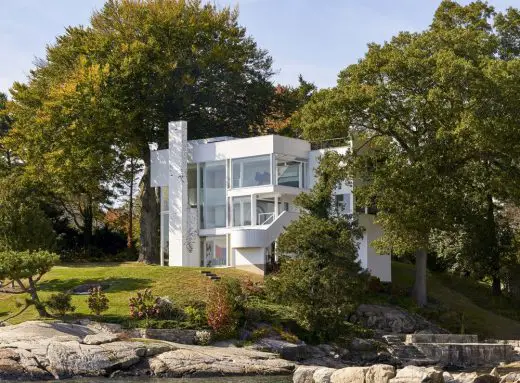
Darien property photo © Mike Schwartz
Smith House, Connecticut
Common Ground High School, New Haven
Design: Gray Organschi Architecture
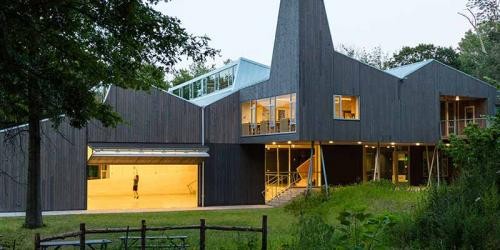
New Haven building photograph : David Sundberg
New Haven High School Building
Philip Johnson Glass House News, New Canaan
Date built: 1949; Architect: Philip Johnson
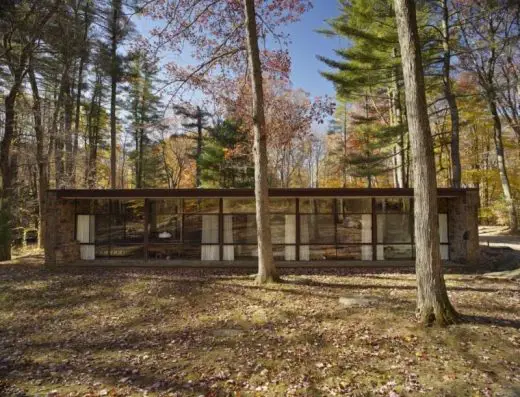
photo : Michael Biondo
Philip Johnson’s Glass House
Residential Playhouse, Greenwich
Design: Austin Patterson Disston Architects
New Connecticut House in Greenwich
American Architecture Designs
American Architectural Designs – recent selection from e-architect:
America Architecture News – latest building updates
American Architect Studios
Comments / photos for the Bruce Museum in Greenwich – Connecticut Architecture design by EskewDumezRipple, USA, page welcome.

